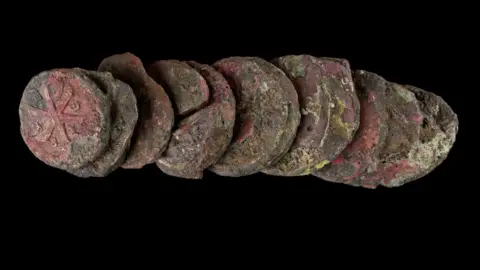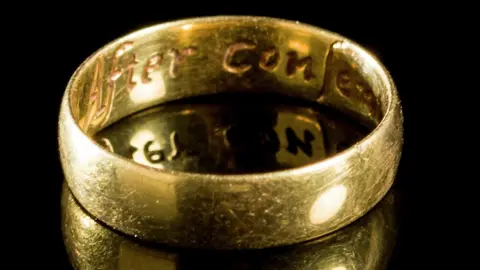Coins, brooches and rings found in north Wales declared treasure
 National Museum Wales
National Museum WalesCoins, brooches and rings found across north Wales have been declared treasure by a coroner.
The 10 finds by members of the public date from the Roman, medieval and post-medieval periods.
They were discovered between 2016 and 2018 and assistant coroner Joanne Lees declared them treasure at a hearing in Ruthin, Denbighshire earlier.
One haul of 15 Roman coins near Ruthin was found by Aled Roberts on his first dig with a metal detectorist club.
National Museum Wales said the finds were "of great benefit in helping us to understand Wales' unique history".
The oldest find was six Roman coins discovered by Andy Jones in Sesswick, Wrexham county, which included some from the 2nd Century and featured Emperors Hadrian (AD 117-38) and Antoninus Pius (AD 138-61).
 National Museum Wales
National Museum WalesTo be classed as treasure, gold and silver items must contain at least 10% precious metal and all finds must be at least 300 years old.
Museums in the areas of each of the finds, or the National Museum of Wales, are interested in acquiring all of the treasure.
Dr Mark Redknap of National Museum Wales, said: "Some of the items declared treasure today, such as the decorative medieval brooches, reflect personal style, while fede rings had deep personal significance, with legends reflecting fidelity and love."
 National Museum Wales
National Museum WalesTreasure finds:
- Roman coin from Llanynys, Denbighshire
- Roman coin from Sesswick, Wrexham
- Medieval silver gilt crucifix from Cwm, Denbighshire
- Medieval silver finger ring from Rossett, Wrexham
- Medieval silver brooch from Holt, Wrexham
- Medieval silver brooch from Cilcain, Flintshire
- Part of a medieval coin hoard from Bronington, Wrexham
- Post-medieval gold finger ring from Abergele, Conwy
- Post-medieval silver seal matrix from Llanfair Dyffryn Clwyd, Denbighshire
- Post-medieval gold finger ring from Esclusham, Wrexham
